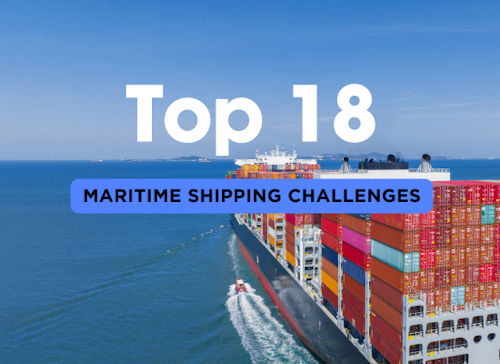Top 18 Maritime Shipping Challenges

The maritime shipping industry is fraught with challenges that can significantly impact operations, profitability, and safety. From piracy threats and stringent environmental regulations to supply chain disruptions, the industry must navigate a complex landscape to ensure smooth and efficient operations. Addressing these challenges requires a combination of strategic planning, technological innovation, and adherence to best practices. Today we explore the top 18 challenges in maritime shipping and provides actionable solutions to overcome them, starting with the first three critical issues.
** Please send comments/suggestions to editor @ shipuniverse.com **
1. Piracy and Maritime Security
Challenge: Piracy remains one of the most significant threats to maritime shipping, particularly in high-risk areas such as the Gulf of Aden, the Strait of Malacca, and the waters off West Africa. Pirates target vessels for ransom, cargo theft, and hijacking, posing a severe risk to crew safety and the security of valuable cargo.
Solution:
- Enhanced Security Measures: Shipping companies can mitigate piracy risks by implementing enhanced security measures, such as deploying armed security personnel on board vessels, installing advanced surveillance and communication systems, and using non-lethal deterrents like water cannons and sonic devices.
- Adherence to Best Management Practices (BMP): Following the industry-standard Best Management Practices (BMP) guidelines helps reduce the likelihood of pirate attacks. These practices include maintaining high speeds in high-risk areas, conducting regular security drills, and using secure anchorages.
- International Collaboration: Collaborating with international naval forces and participating in regional security initiatives, such as the Combined Maritime Forces (CMF) and Operation Atalanta, can provide additional protection for vessels transiting high-risk areas.
2. Environmental Regulations and Compliance
Challenge: The shipping industry is under increasing pressure to comply with stringent environmental regulations aimed at reducing greenhouse gas emissions, sulfur content in fuel, and overall environmental impact. The International Maritime Organization (IMO) has set ambitious targets, such as the IMO 2020 regulation, which limits sulfur content in marine fuel to 0.5%, and the IMO's 2050 strategy to reduce greenhouse gas emissions by at least 50% compared to 2008 levels.
Solution:
- Adopting Cleaner Fuels: Transitioning to low-sulfur fuels, such as Marine Gas Oil (MGO) or Liquefied Natural Gas (LNG), is essential for compliance with IMO regulations. Additionally, investing in exhaust gas cleaning systems (scrubbers) can help ships meet emission standards while continuing to use traditional fuels.
- Energy Efficiency Measures: Implementing energy efficiency measures, such as optimizing vessel speed, improving hull design, and utilizing energy-saving devices like air lubrication systems and propeller boss cap fins, can reduce fuel consumption and emissions.
- Carbon Offset Programs: Participating in carbon offset programs, such as purchasing carbon credits or investing in renewable energy projects, can help shipping companies offset their carbon footprint and demonstrate their commitment to sustainability.
3. Supply Chain Disruptions
Challenge: Supply chain disruptions, whether due to natural disasters, geopolitical tensions, pandemics, or port congestion, can severely impact shipping schedules, increase costs, and lead to significant delays. The COVID-19 pandemic, for example, caused widespread disruptions in global supply chains, leading to container shortages, port closures, and a sharp increase in freight rates.
Solution:
- Diversifying Supply Chains: Diversifying supply chains by sourcing from multiple suppliers and regions can reduce dependency on a single source and mitigate the impact of disruptions. Companies should also consider nearshoring or reshoring production to reduce reliance on distant suppliers.
- Digitalization and Predictive Analytics: Leveraging digital tools and predictive analytics can help shipping companies anticipate potential disruptions and take proactive measures. Technologies like IoT, AI, and blockchain can provide real-time visibility into supply chains, enabling more informed decision-making.
- Building Resilience: Establishing contingency plans, such as alternative routing options, flexible contracts, and maintaining buffer stock, can help companies respond quickly to supply chain disruptions and minimize their impact.
4. Crew Shortages and Workforce Management
Challenge: The maritime industry faces a significant challenge in attracting and retaining skilled crew members. An aging workforce, combined with a lack of new entrants, is leading to crew shortages that can impact ship operations, safety, and compliance. Additionally, the demanding nature of life at sea, including long periods away from home, can lead to high turnover rates and difficulties in workforce management.
Solution:
- Investing in Training and Development: Shipping companies should invest in comprehensive training and development programs to upskill existing crew members and attract new talent. Offering specialized courses, certification programs, and continuous learning opportunities can help build a skilled and motivated workforce.
- Improving Working Conditions: Enhancing working conditions on board, such as better accommodation, improved communication with families, and access to mental health support, can make the seafaring profession more attractive and reduce turnover rates.
- Adopting Automation and Technology: To mitigate the impact of crew shortages, companies can explore the adoption of automation and remote operation technologies. For example, the use of autonomous systems for routine tasks can reduce the burden on crew members and increase operational efficiency.
5. Regulatory Compliance and Bureaucracy
Challenge: The maritime industry is highly regulated, with a complex web of international, regional, and national regulations governing everything from ship safety and environmental protection to labor standards and trade compliance. Navigating this regulatory landscape can be challenging, particularly as new regulations are introduced and existing ones are updated. Non-compliance can lead to significant fines, legal liabilities, and reputational damage.
Solution:
- Implementing Compliance Management Systems: Establishing robust compliance management systems that track regulatory changes, ensure adherence to relevant standards, and manage documentation can help companies stay compliant. Software solutions that automate compliance processes can reduce the administrative burden and minimize the risk of human error.
- Engaging with Regulatory Bodies: Proactive engagement with regulatory bodies, industry associations, and classification societies can help companies stay informed about upcoming regulatory changes and participate in the regulatory process. This engagement can also provide opportunities to advocate for more practical and industry-friendly regulations.
- Regular Audits and Inspections: Conducting regular internal audits and third-party inspections can help identify potential compliance gaps and address them before they lead to violations. These audits should cover all aspects of operations, including safety, environmental performance, and labor practices.
6. Cybersecurity Threats
Challenge: As the maritime industry becomes increasingly digitalized, the threat of cyberattacks is growing. Cybercriminals can target shipping companies, vessels, and ports, leading to disruptions in operations, data breaches, and financial losses. The interconnected nature of maritime operations means that a successful cyberattack on one part of the supply chain can have far-reaching consequences for the entire network.
Solution:
- Strengthening Cybersecurity Protocols: Shipping companies must implement robust cybersecurity protocols to protect their digital infrastructure. This includes using firewalls, encryption, multi-factor authentication, and regular software updates to safeguard against cyber threats.
- Employee Training and Awareness: Educating employees and crew members about cybersecurity risks and best practices is crucial in preventing cyber incidents. Regular training sessions, phishing simulations, and clear protocols for reporting suspicious activity can help build a culture of cybersecurity awareness.
- Collaboration and Information Sharing: Collaborating with industry partners, government agencies, and cybersecurity firms can enhance the maritime industry’s collective defense against cyber threats. Information sharing about emerging threats, vulnerabilities, and incidents can help companies stay ahead of potential risks.
7. Port Congestion
Challenge: Port congestion is a persistent issue that can severely disrupt global shipping operations. Congestion occurs when ports are overwhelmed by the volume of vessels and cargo, leading to delays in loading and unloading, increased waiting times for ships, and a ripple effect across supply chains. Contributing factors include limited port capacity, labor shortages, inefficient port operations, and surges in demand, particularly during peak seasons.
Solution:
- Investing in Port Infrastructure: Expanding port capacity, upgrading equipment, and improving infrastructure can help alleviate congestion. This includes adding more berths, enhancing cargo handling systems, and investing in automation technologies to increase throughput.
- Optimizing Port Operations: Implementing advanced scheduling and logistics management systems can help ports manage vessel traffic more efficiently. Real-time tracking of ship movements, predictive analytics, and coordination with shipping lines can reduce bottlenecks and improve turnaround times.
- Diversifying Port Usage: Shipping companies can mitigate the impact of congestion by diversifying the ports they use. Relying on multiple ports, including smaller or less congested ones, can reduce dependency on major hubs and distribute cargo more evenly across the network.
8. Container Shortages
Challenge: Container shortages have become a significant challenge in the maritime industry, particularly in the wake of the COVID-19 pandemic. Disruptions in global trade, uneven demand recovery, and logistical bottlenecks have led to an imbalance in the availability of shipping containers. This shortage has driven up shipping costs, caused delays, and created inefficiencies in the movement of goods.
Solution:
- Improving Container Logistics: Better management of container logistics, including more efficient repositioning of empty containers, can help address shortages. Technologies like AI and blockchain can optimize container usage and improve tracking, ensuring that containers are where they are needed most.
- Leasing and Sharing Containers: Shipping companies can explore leasing or sharing containers as a flexible solution to meet demand during peak periods. Collaborative platforms that allow companies to share container space or lease excess capacity can reduce the impact of shortages.
- Investing in New Containers: In the long term, investing in new container production, particularly in regions with high demand, can help alleviate shortages. This requires a coordinated effort across the industry to ensure a steady supply of containers to meet global trade needs.
9. Fluctuating Fuel Prices
Challenge: Fuel costs are one of the most significant operating expenses for shipping companies, and fluctuations in fuel prices can have a considerable impact on profitability. The volatility of oil prices, driven by geopolitical events, supply-demand imbalances, and regulatory changes (such as the IMO 2020 sulfur cap), adds to the uncertainty in fuel costs. This can make budgeting and financial planning challenging for shipping companies.
Solution:
- Hedging Fuel Costs: Shipping companies can use financial instruments like fuel hedging to protect against price volatility. By locking in fuel prices at a predetermined rate, companies can stabilize their costs and reduce the risk of unexpected price spikes.
- Adopting Fuel-Efficient Technologies: Investing in fuel-efficient technologies, such as energy-saving devices, optimized hull designs, and slow steaming practices, can reduce fuel consumption and mitigate the impact of price fluctuations. Additionally, transitioning to alternative fuels like LNG or exploring hybrid propulsion systems can offer cost savings and regulatory compliance benefits.
- Implementing Surcharges and Contracts: Shipping companies can include fuel surcharges in their contracts with customers to pass on some of the cost fluctuations. Long-term contracts that include clauses for fuel price adjustments can provide more predictable revenue streams and help manage the financial impact of fuel price volatility.
10. Geopolitical Tensions and Trade Wars
Challenge: Geopolitical tensions and trade wars pose significant challenges to the maritime shipping industry by disrupting established trade routes, creating uncertainty in global markets, and leading to increased tariffs and sanctions. These conflicts can result in sudden changes in shipping demand, rerouting of vessels, and delays due to increased customs inspections and regulatory hurdles.
Solution:
- Diversifying Trade Routes: Shipping companies can mitigate the risks associated with geopolitical tensions by diversifying their trade routes and markets. By not relying too heavily on any single trade corridor, companies can adapt more easily to sudden disruptions.
- Building Strategic Alliances: Forming strategic alliances with partners in various regions can provide access to alternative routes and markets, reducing the impact of trade wars on a company’s operations. Collaborating with regional partners can also offer insights into navigating complex political landscapes.
- Monitoring Political Developments: Staying informed about global political developments and engaging with international trade organizations can help shipping companies anticipate changes and adjust their strategies accordingly. Proactive engagement with policymakers can also influence favorable trade policies.
11. Climate Change and Extreme Weather Events
Challenge: Climate change is increasing the frequency and severity of extreme weather events, such as hurricanes, typhoons, and floods, which can disrupt shipping operations, damage vessels, and cause delays. Rising sea levels and changing weather patterns also pose long-term risks to port infrastructure and shipping routes.
Solution:
- Investing in Climate-Resilient Infrastructure: Ports and shipping companies should invest in infrastructure that is resilient to climate change, such as elevated docks, reinforced breakwaters, and flood defenses. Building or retrofitting infrastructure to withstand extreme weather events can reduce the impact of climate-related disruptions.
- Implementing Weather Monitoring Systems: Advanced weather monitoring and forecasting systems can help shipping companies anticipate and avoid extreme weather events. By incorporating real-time weather data into route planning, companies can reroute vessels to safer waters and minimize delays.
- Adopting Sustainable Practices: To address the broader issue of climate change, shipping companies should adopt sustainable practices, such as reducing greenhouse gas emissions, transitioning to cleaner fuels, and participating in carbon offset programs. These measures not only contribute to global climate goals but can also enhance a company’s reputation and competitiveness.
12. Cargo Theft
Challenge: Cargo theft is a significant risk in the maritime industry, particularly during transshipment at ports, during inland transport, or while vessels are docked. High-value goods, such as electronics, pharmaceuticals, and luxury items, are particularly vulnerable. Cargo theft can lead to financial losses, insurance claims, and delays in delivery, impacting both the shipping company and the cargo owner.
Solution:
- Enhancing Security Measures: Implementing advanced security measures, such as GPS tracking, tamper-evident seals, and secure locks, can help deter cargo theft. Shipping companies should also invest in surveillance systems and conduct regular security audits to identify vulnerabilities.
- Training and Awareness Programs: Training staff on security protocols and raising awareness about cargo theft risks can help prevent incidents. Encouraging a culture of vigilance and reporting suspicious activities can reduce the likelihood of theft.
- Collaborating with Law Enforcement: Working closely with local and international law enforcement agencies can improve the chances of recovering stolen goods and apprehending criminals. Participation in industry networks that share information on cargo theft incidents can also help companies stay informed and take preventive action.
13. Insurance Costs and Liability
Challenge: The maritime industry is facing rising insurance costs, driven by a variety of factors including the increased risk of piracy, environmental liabilities, and the complexity of global shipping operations. Additionally, liability issues such as accidents, cargo damage, and environmental spills can lead to significant financial losses and legal challenges for shipping companies.
Solution:
- Comprehensive Risk Assessment: Conducting thorough risk assessments for each voyage and port of call can help shipping companies identify potential hazards and take preventive measures. This includes evaluating routes for piracy risk, assessing weather conditions, and ensuring compliance with environmental regulations.
- Optimizing Insurance Coverage: Shipping companies should work closely with insurance providers to ensure that they have adequate coverage for all potential risks. This may involve customizing insurance policies to cover specific liabilities, such as environmental damage or cargo loss, and exploring options for group insurance or self-insurance to reduce costs.
- Implementing Safety and Compliance Programs: Adopting rigorous safety and compliance programs can help reduce the likelihood of incidents that lead to insurance claims. Regular training, maintenance, and audits can ensure that vessels and crews operate safely and in compliance with all relevant regulations.
14. Technological Disruption and Integration
Challenge: The rapid pace of technological change presents both opportunities and challenges for the maritime industry. While new technologies such as automation, artificial intelligence (AI), and blockchain offer the potential to enhance efficiency, they also require significant investment and can be difficult to integrate with existing systems. Moreover, the lack of standardized technology across the industry can lead to compatibility issues and hinder the adoption of innovative solutions.
Solution:
- Investing in Scalable Technology: Shipping companies should invest in scalable and flexible technologies that can be easily integrated with existing systems. This includes choosing solutions that are compatible with industry standards and can be updated or expanded as new technologies emerge.
- Fostering a Culture of Innovation: Encouraging a culture of innovation within the organization can help drive the adoption of new technologies. This includes providing training and support for employees to learn new skills, as well as creating teams or departments dedicated to exploring and implementing technological advancements.
- Collaborating with Technology Providers: Partnering with technology providers and industry consortia can help shipping companies stay at the forefront of technological developments. Collaborative efforts can lead to the creation of industry standards, ensuring that new technologies are interoperable and beneficial for the entire maritime ecosystem.
15. Environmental Pollution and Sustainability Pressures
Challenge: Environmental pollution, particularly from ship emissions, ballast water discharge, and marine litter, is a major concern for the maritime industry. Shipping companies are under increasing pressure from regulators, consumers, and environmental groups to reduce their environmental footprint. Failure to address these concerns can lead to stricter regulations, higher operational costs, and reputational damage.
Solution:
- Adopting Green Technologies: Shipping companies can reduce their environmental impact by adopting green technologies such as scrubbers, ballast water treatment systems, and energy-efficient propulsion systems. These technologies not only help comply with environmental regulations but also contribute to long-term sustainability goals.
- Implementing Zero-Waste Practices: Embracing zero-waste practices, such as minimizing plastic use, reducing onboard waste, and recycling materials, can significantly reduce marine pollution. Companies can also participate in initiatives that promote ocean cleanup and the prevention of marine litter.
- Engaging in Corporate Social Responsibility (CSR): Developing and implementing CSR programs that focus on environmental stewardship can enhance a company’s reputation and build trust with stakeholders. These programs can include initiatives such as supporting marine conservation projects, reducing carbon emissions, and promoting sustainable practices within the industry.
16. Ship Maintenance and Repair
Challenge: Regular maintenance and timely repairs are crucial for ensuring the safety, efficiency, and longevity of vessels. However, the complexity and cost of maintaining large ships can be a significant challenge, particularly for older vessels or those operating in harsh marine environments. Delays in maintenance can lead to costly breakdowns, unplanned downtime, and even accidents.
Solution:
- Proactive Maintenance Scheduling: Implementing a proactive maintenance schedule that includes regular inspections, preventive maintenance, and timely repairs can help avoid unexpected breakdowns. Leveraging predictive maintenance technologies, such as IoT sensors and AI-driven analytics, can further enhance the ability to anticipate and address potential issues before they escalate.
- Investing in Quality Materials and Parts: Using high-quality materials and parts for repairs and maintenance can extend the life of a vessel and reduce the frequency of maintenance needs. Shipping companies should work with trusted suppliers and invest in durable, corrosion-resistant materials that can withstand the rigors of marine environments.
- Strategic Use of Dry Docks: Planning dry dock periods strategically, such as during off-peak seasons or when a vessel is already scheduled for downtime, can minimize disruptions to operations. Coordinating with shipyards to ensure the availability of skilled labor and necessary parts can also expedite the maintenance process.
17. Managing Global Talent and Cultural Differences
Challenge: The maritime industry is inherently global, with crews and staff coming from diverse cultural backgrounds. Managing a multicultural workforce presents challenges related to communication, teamwork, and compliance with varying labor regulations. Additionally, attracting and retaining talent in a competitive global market requires understanding and addressing the unique needs of a diverse workforce.
Solution:
- Cultural Awareness Training: Providing cultural awareness training for crew members and shore-based staff can help bridge cultural differences and foster better communication and teamwork. Understanding cultural norms, communication styles, and conflict resolution approaches can enhance collaboration and reduce misunderstandings.
- Global Talent Management Strategies: Developing talent management strategies that account for regional differences in labor markets, regulations, and employee expectations is essential. This includes offering competitive compensation, career development opportunities, and tailored benefits packages that appeal to a diverse workforce.
- Promoting Inclusivity: Creating an inclusive work environment where all employees feel valued and respected can improve morale and reduce turnover. This can be achieved through policies that promote diversity, equity, and inclusion, as well as initiatives that celebrate cultural diversity within the organization.
18. Navigating Economic Uncertainty
Challenge: Economic uncertainty, driven by factors such as fluctuating global trade volumes, currency exchange rates, and changes in consumer demand, can pose significant challenges for the maritime shipping industry. Economic downturns can lead to reduced shipping volumes, lower freight rates, and increased financial pressure on shipping companies.
Solution:
- Diversifying Revenue Streams: To mitigate the impact of economic downturns, shipping companies can diversify their revenue streams by exploring new markets, expanding service offerings (such as logistics or supply chain management), and investing in related industries (such as port operations or shipbuilding).
- Financial Risk Management: Implementing financial risk management strategies, such as hedging against currency fluctuations, securing long-term contracts with stable rates, and maintaining a healthy cash reserve, can help companies navigate economic uncertainty more effectively.
- Agile Business Models: Adopting an agile business model that allows for quick adjustments to changing market conditions can improve a company’s resilience. This includes the ability to scale operations up or down, pivot to new markets, or shift focus to more profitable services as economic conditions change.
Summary
| ShipUniverse: Article Summary | |
|---|---|
| Challenge | Summary of Solutions |
| Piracy and Maritime Security |
- Enhance security measures (armed personnel, surveillance). - Follow Best Management Practices (BMP). - Collaborate with international naval forces. |
| Environmental Regulations and Compliance |
- Adopt cleaner fuels and scrubbers. - Implement energy efficiency measures. - Participate in carbon offset programs. |
| Supply Chain Disruptions |
- Diversify supply chains and sourcing. - Use digital tools and predictive analytics. - Build resilience with contingency plans. |
| Crew Shortages and Workforce Management |
- Invest in training and development. - Improve working conditions and mental health support. - Adopt automation to reduce crew burden. |
| Regulatory Compliance and Bureaucracy |
- Implement compliance management systems. - Engage with regulatory bodies. - Conduct regular audits and inspections. |
| Cybersecurity Threats |
- Strengthen cybersecurity protocols. - Provide employee training and awareness. - Collaborate on information sharing. |
| Port Congestion |
- Invest in port infrastructure and automation. - Optimize port operations with advanced scheduling. - Diversify port usage to avoid bottlenecks. |
| Container Shortages |
- Improve container logistics with technology. - Explore leasing and sharing containers. - Invest in new container production. |
| Fluctuating Fuel Prices |
- Use fuel hedging to stabilize costs. - Adopt fuel-efficient technologies. - Implement surcharges and flexible contracts. |
| Geopolitical Tensions and Trade Wars |
- Diversify trade routes and markets. - Build strategic alliances. - Monitor political developments closely. |
| Climate Change and Extreme Weather Events |
- Invest in climate-resilient infrastructure. - Use advanced weather monitoring systems. - Adopt sustainable practices to reduce environmental impact. |
| Cargo Theft |
- Enhance security measures (GPS, tamper-evident seals). - Provide training and awareness for staff. - Collaborate with law enforcement and industry networks. |
| Insurance Costs and Liability |
- Conduct comprehensive risk assessments. - Optimize insurance coverage. - Implement safety and compliance programs. |
| Technological Disruption and Integration |
- Invest in scalable, compatible technology. - Foster a culture of innovation. - Collaborate with technology providers and industry consortia. |
| Environmental Pollution and Sustainability Pressures |
- Adopt green technologies (scrubbers, energy-efficient systems). - Implement zero-waste practices. - Engage in Corporate Social Responsibility (CSR) programs. |
| Ship Maintenance and Repair |
- Implement proactive maintenance schedules. - Invest in quality materials and parts. - Strategically plan dry dock periods. |
| Managing Global Talent and Cultural Differences |
- Provide cultural awareness training. - Develop global talent management strategies. - Promote inclusivity and diversity. |
| Navigating Economic Uncertainty |
- Diversify revenue streams. - Implement financial risk management strategies. - Adopt agile business models. |

Do you have a Maritime Product or Service that may be of interest to Shipowners? Tell us about it here!
Do you have feedback or insights? Please reach out to editor @ shipuniverse.com



